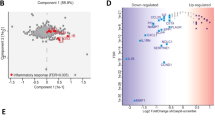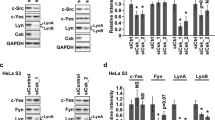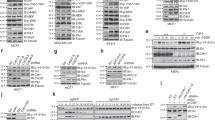Abstract
Tumors that overexpress HER-2/neu receptor or exhibit enhanced EGFR signaling have been reported to possess constitutively activated Src family kinases, especially pp60c-Src. High levels of pp60c-Src activity have also been reported for cell lines that overexpress the EGFR or the chimeric EGFR-HER-2 receptor. It has therefore been suggested that Src kinases may contribute significantly to the oncogenic phenotype of these cells and to the degree of malignancy of tumors that overexpress EGFR family receptors. In this study we show that the induced expression of c-SRC antisense RNA or the application of a selective Src kinase inhibitor induces growth arrest, programmed cell death and reverses the transformed properties of cells that overexpress EGFR or HER-2 receptors. We show that inhibition of Src kinase expression or activity results in the reduction of Stat3 tyrosine phosphorylation, decline of Bcl-XL expression, and induction of cell death. Using a construct in which the promoter of Bcl-X, which possesses putative Stat3 sites, is tethered to the luciferase reporter gene, we show that inhibition of Src activity or expression induces a decline in Bcl-X expression. We also show that the expression of activated Src induces activation of the Bcl-X promoter. This activation is inhibited by the expression of kinase dead Src or of Stat3β, the dominant-negative form of Stat3. Taken together, these results support the hypothesis that Src positively regulates the transformed phenotype of cells overexpressing EGFR family kinases. Furthermore, these results also suggest that Src positively regulates Bcl-XL expression via Stat3 activation and thus acts not only as a potent mitogenic signaling element, but also as an anti-apoptotic signaling protein. The combination of both activities probably confers upon activated Src its oncogenic activity. Since Src kinase is activated in many tumors, pp60c-Src kinase inhibitors may prove useful as anti-cancer agents for many types of cancer.
This is a preview of subscription content, access via your institution
Access options
Subscribe to this journal
Receive 50 print issues and online access
$259.00 per year
only $5.18 per issue
Buy this article
- Purchase on Springer Link
- Instant access to full article PDF
Prices may be subject to local taxes which are calculated during checkout







Similar content being viewed by others
References
Ben-Bassat H, Vardi DV, Gazit A, Klaus SN, Chaouat M, Hartzstark Z and Levitzki A. . 1995 Exp. Dermatol. 4: 82–88.
Broome MA and Hunter T. . 1996 J. Biol. Chem. 271: 16796–16806.
Bromberg JF, Horvath CM, Besser D, Lathem WW and Darnell Jr. JE. . 1998 Mol. Cell Biol., 18: 2553–2558.
Brunton VG, Ozanne BW, Paraskeva C and Frame MC. . 1997 Oncogene 14: 283–293.
Cao X, Tay A, Guy GR and Tan YH. . 1996 Mol. Cell Biol. 16: 1595–1603.
Catlett-Falcone R, Landowski TH, Oshiro MM, Turkson J, Levitzki A, Savino R, Ciliberto G, Moscinski L, Fernandez-Luna JL, Nunez G, Dalton WS and Jove R. . 1999 Immunity 10: 105–115.
Courtneidge SA, Dhand R, Pilat D, Twamley GM, Waterfield MD and Roussel M. . 1993 EMBO J. 12: 943–950.
Erpel T and Courtneidge S. . 1995 Curr. Opin. Cell 7: 176–182.
Fu XY and Zhang JJ. . 1993 Cell 74: 1135–1145.
Gillet G, Guerin M, Trembleau A and Brun G. . 1995 EMBO J. 14: 1372–1381.
Gossen M and Bujard H. . 1992 Proc. Natl. Acad Sci. USA 89: 5547–5551.
Grillot DA, Gonzalez-Garcia M, Ekhterae D, Duan L, Inohara N, Ohta S, Seldin MF and Nunez G. . 1997 J. Immunol. 158: 4759–4757.
Hanke JH, Gardner JP, Dow RL, Changelian PS, Brissette WH, Weringer EJ, Pollok BA and Connelly PA. . 1996 J. Biol. Chem. 271: 695–701.
Imamoto A, Soriano P and Stein PL. . 1994 Curr. Opin. Genet. Dev. 4: 40–46.
Levitzki A. . 1996 Anti-Cancer Drug Design. 8: 239–244.
Maa MC, Leu TH, McCarley DJ, Schatzman RC and Parsons SJ. . 1995 Proc. Natl. Acad Sci. USA 92: 6981–6985.
Mangeney M, Schmitt JR, Leverrier Y, Thomas J, Marve J, Brun G and Gillet G. . 1996 Oncogene 13: 1441–1446.
McGill G, Shimamura A, Bates RC, Savage RE and Fisher DE. . 1997 J. Cell Biol. 138: 901–911.
Ottenholff-Kalff AE, Rijksen G, Van Beurden EA, Hennipman A, Michels A and Staal GE. . 1992 Cancer Res. 52: 4773–4778.
Osherov N and Levitzki A. . 1994 Eur. J. Biochem. 225: 1047–1053.
Parrizas M and LeRoith D. . 1997 Endocrinology 138: 1355–1358.
Parsons JT and Parsons SJ. . 1997 Curr. Opin. Cell Biol. 9: 187–192.
Peterson JE, Kulik G, Jelinek T, Reuter WM, Shannon JA and Weber MJ. . 1996 J. Biol. Chem. 271: 31562–31571.
Sabe H, Hamaguchi M and Hanafusa H. . 1997 Oncogene 14: 1779–1788.
Sanes JR, Rubenstein JL and Nicolas JF. . 1986 EMBO J. 5: 3133–3142.
Sato K, Sato A, Aoto M and Fukami Y. . 1995 Biochem. Biophy. Res. Comm. 210: 844–851.
Schindler T, Sicheri F, Pico A, Gazit A, Levitzki A and Kuriyun J. . 1999 Mol. Cell in press.
Stover DR, Becker M, Liebetanz J and Lydon NB. . 1995 J. Biol. Chem. 270: 15591–15597.
Turkson J, Bowman T, Garcia R, Caldenhoven E, de Groot RP and Jove R. . 1998 Mol. Cell Biol. 18: 2545–2552.
Van de Vijver MJ, Kumar R and Mendelsohn J. . 1991 J. Biol. Chem. 266: 7503–7508.
Verbeek BS, Vroom TM, Adriaansen-Slot SS, Ottenhoff-Kalff AE, Geertzema JG, Hennipman A and Rijksen G. . 1996 J. Pathol. 180: 383–388.
Yu CL, Meyer DJ, Campbell GS, Larner AC, Carter-Su C, Schwartz J and Jove R. . 1995 Science 269: 81–83.
Acknowledgements
We would like to thank Dr Ricardo Martinez from SUGEN, Inc. for providing us with the mouse SRC cDNA. We also thank Dr Shoshana Klein and Dr Allan Bar-Sinai from our laboratory for their help preparing the manuscript. This study was partially supported by The James S McDonnel Foundation (USA) and partially by The Israel Science Foundation of the Israel Academy of Sciences and Humanities, Jerusalem, Israel.
Author information
Authors and Affiliations
Rights and permissions
About this article
Cite this article
Karni, R., Jove, R. & Levitzki, A. Inhibition of pp60c-Src reduces Bcl-XL expression and reverses the transformed phenotype of cells overexpressing EGF and HER-2 receptors. Oncogene 18, 4654–4662 (1999). https://doi.org/10.1038/sj.onc.1202835
Received:
Revised:
Accepted:
Published:
Issue Date:
DOI: https://doi.org/10.1038/sj.onc.1202835
Keywords
This article is cited by
-
4EBP1 senses extracellular glucose deprivation and initiates cell death signaling in lung cancer
Cell Death & Disease (2022)
-
Src family kinases, adaptor proteins and the actin cytoskeleton in epithelial-to-mesenchymal transition
Cell Communication and Signaling (2021)
-
Trillin prevents proliferation and induces apoptosis through inhibiting STAT3 nuclear translocation in hepatoma carcinoma cells
Medical Oncology (2020)
-
Search for novel STAT3-dependent genes reveals SERPINA3 as a new STAT3 target that regulates invasion of human melanoma cells
Laboratory Investigation (2019)
-
Clinicopathological and Prognostic Role of STAT3/p-STAT3 in Breast Cancer Patients in China: A Meta-Analysis
Scientific Reports (2019)



